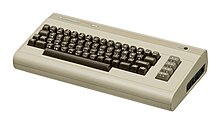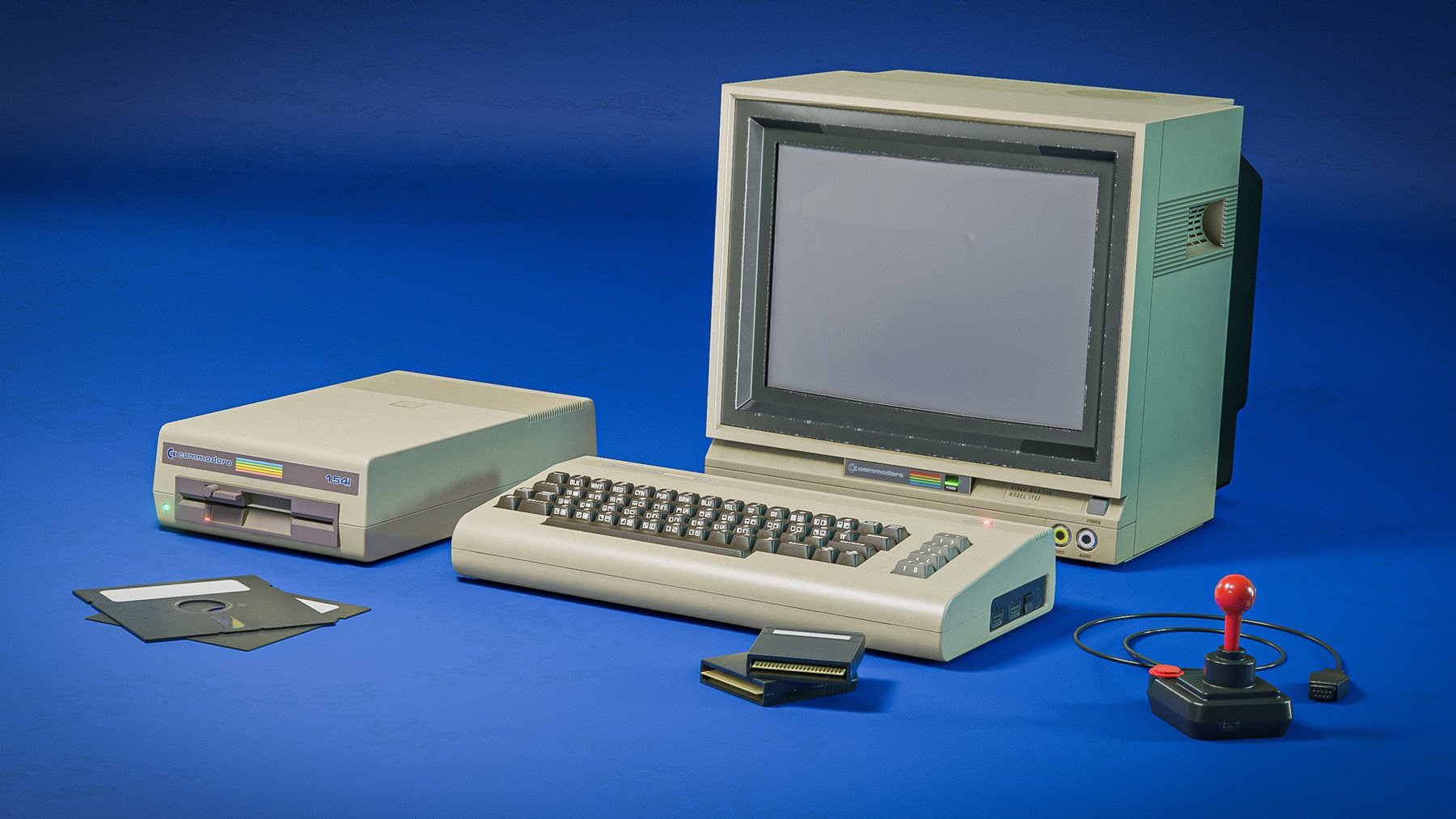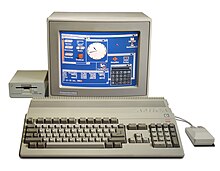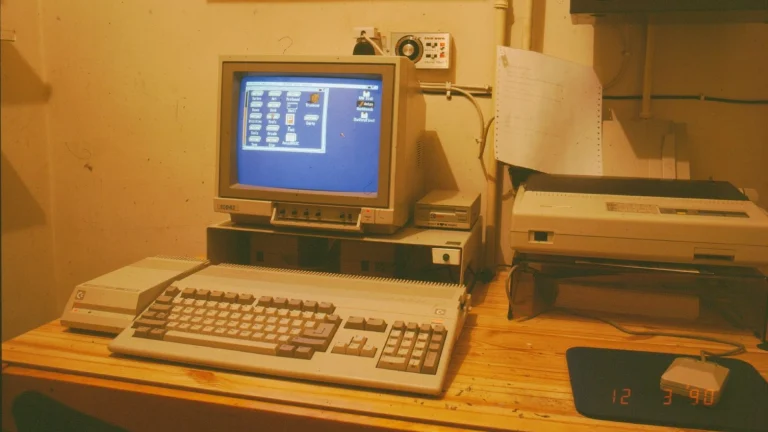I have been a technology enthusiast since I was 10 years old, today I repair computers and provide solutions to everyday computer challenges for home users and very small businesses. To find out more about me, visit my home page.
If you want reach out to me about this article, use retrogaming O scottrlarson.com
This article is the second part of a three part series:
- Part 1: My First Computer
- Part 2: The C64 & A500
- Part 3: Amiga Games, The BBS Days & 3d Modeling
Commodore 64
|
|
|

|
|
| Manufacturer | Commodore Business Machines (CBM) |
|---|---|
| Type | Home computer |
| Release date | August 1982[1] |
| Introductory price | US$595 (equivalent to $1,670 in 2021) |
| Discontinued | April 1994 |
| Units sold | 12.5[2] – 17[3] million |
| Operating system | |
| CPU | MOS Technology 6510/8500 |
| Memory | 64 KB (65,536 bytes) (IEC: KiB) RAM + 20 KB ROM |
| Graphics | VIC-II (320×200, 16 colors, sprites, raster interrupt) |
| Sound | SID 6581/8580 (3× osc, 4× wave, filter, ADSR, ring) |
| Connectivity |
|
| Predecessor | |
| Successor | |

Commodore, instrumental in launching the Home Computer movement forward, focused on low-cost alternatives to the mainframe/supercomputer, high-priced market that the juggernauts HP and IBM were involved in at the time. Many people in the business world considered home computers toys and they would never gain the status and profitability of designing computers for the corporate world. Because of this mindset, there was a lot of controversy around the introduction of the home computer, with back-biting executives sabotaging projects to CEOs running projects into the ground.
It took people like Commodore’s Founder Jack Tramiel who understood where technology was heading to shift the tide.
We build computers for the masses, not the classes.
- Jack Tramiel (Commodore’s Founder).
The C64 was my first computer, if you were using computers at the time, it was likely your first computer too. Simplicity, low cost, superior graphics, quality sound, good game software, and aggressive marketing made the C64 the perfect home computer for enthusiasts like me and many others.
Tinkering communities formed around the C64’s simple design and broad software support. It was a bit like the cassette tape area. We became fascinated with the C64’s capabilities by testing the limits of hardware, playing with software that did cool things, and sharing it with the community.
The C64 inspired a whole slew of independent software designed by people for people, who ultimately just wanted to share their creations.
Commodore Amiga 500
|
|
|

A500 with 1084S monitor and Amiga 1010 external second floppy drive
|
|
| Developer | Commodore International |
|---|---|
| Product family | Amiga |
| Type | Home computer |
| Release date | April 1987 (Netherlands) May 1987 (Europe) October 1987 (US/UK) |
| Introductory price |
|
| Discontinued | 1992 |
| Units sold | 4 to 5 million[1] |
| Media | 880 KB floppy disks |
| Operating system | AmigaOS v1.2 – 1.3 (upgradable to current version if enough RAM is installed) |
| CPU | Motorola 68000 @ 7.16 MHz (NTSC) 7.09 MHz (PAL) |
| Memory | 512 or 1024 KB 150 ns (maximum 9 to 138 MB, depending on upgrades)[2][a] |
| Display | 736×567i 4 bpp (PAL) 736×483i 4 bpp (NTSC) 368×567i 6 bpp (PAL) 368×483i 6 bpp (NTSC) |
| Graphics | Denise |
| Sound | 4× 8-bit channels PCM at max. 28 kHz with 6-bit volume in stereo |
| Predecessor | Amiga 1000 |
| Successor | |

Like the first mission to the moon, the technology behind the Amiga 500 Home Computer changed everything. The A500 had its beginnings at Atari. An engineer, Jay Miner, had an idea to develop a computer that would revolutionize games and make them much easier to develop.
Too afraid of losing money, Atari corporate executives of that time put little-to-no energy into paradigm-shifting innovations. This decline was in the process of causing the game console industry to collapse. Game development relied heavily on licensing expensive hardware. Due to the fear of losing those licensing deals, Atari prohibited Jay from perusing this new platform.
Realizing the writing on the wall, Jay left Atari. A previous co-worker contacted him and eventually helped him revive the idea under a new company. The technology behind the A500’s hardware design was revolutionary, beyond anything that was developed at the time.
One could say it felt like technology from a future time, as it took years for the rest of the industry to catch up. Suddenly, no longer bound to monochrome displays and single-tone beeps, studio-quality video, and sound became a reality. Eventually, Commodore bought the platform and marketed the Amiga to creative people. The A500 became a big hit with computer enthusiasts and entertainment professionals all over the world.
Like the almost-lost home computer revolution, there are other areas in technology today that are stagnating. One such area is how proprietary software is preventing the evolution of technology. Here is an interesting source on this subject. I plan on writing a future article about this subject and for now, this is a placeholder for that content.
Expandability
One of the big selling points of Home Computers was upgradability. Game consoles purchased for the home during that time were solid units, meaning the design principles were static and the hardware couldn’t be changed after the unit was manufactured.
The A500 was one of the first computers released with an open design principle, allowing expandability. It had two expansion slots that accepted hardware expansion devices like hard drives and other peripherals. Also, instead of all the chips being soldiered into the mainboard directly, the chips were mounted onto bases so they could be easily removed and replaced when improved chips became available.
This kind of open architecture was a first for computer enthusiasts, similar to the concept of modularity, parts could be removed, replaced, and upgraded.
For me, that was what really made home computers interesting. I increased my understanding of electronics by exploring its inner workings and expanding its capabilities. This kind of tinkering spurred my continued computer knowledge over the years.
Without this kind of open access to the hardware, I would have never learned how to service computers. Currently, some current mobile technology like phones, tablets, and laptops are being designed around the static and unchanging aspects of the 1980s console era, creating a throw-away culture, completely dependent on for-profit companies that have no interest in open platforms. Consider supporting the right to repair movement and ending creative monopolies.
The Graphical User Interface (GUI)
The Graphical User Interface changed how a computer is operated. It was the first time I realized I could be creative without having to code. I realized that I could create art with a computer through the gestures of my hand.
When I experienced the GUI for the Amiga OS for the first time, I immediately shifted directions. I like the concepts of programming and electronics, but I am much more of a visual person so I started getting familiar with the new graphics, 3d modeling, and audio tools that were being released at the time.
Using a GUI to interact with a computer is like an extension of human perception. As humans, we interact with our environment through the senses. Like an extension between the body and mind, the more intuitive the tool, the more fluid and imaginative one can be with the tool.
Imagination and creativity impact how the world is perceived. The A500 inspired a whole slew of creative endeavors in more creative fields than I can count. Because of this innovation, modern computer technology owes its beginnings to The Amiga platform.
If we go back to the C64 days, computers received instructions from a Command Line Interface (CLI), I.E typing commands to launch programs and work with everyday tasks. There were some limited GUI interfaces that you could load on top of the CLI, but nothing on the scale that the A500 implemented into its operating system.
The whole OS was grounded in a GUI from start to finish, way before the release of Microsoft’s Windows. It’s difficult to quantify the impact the GUI had on my life, but switching from a lifetime of CLI to a GUI is like miraculously being able to see after years of being blind.
This innovation accelerated the adoption of computers. For many people that might have been put off by the command line, Graphic User Interface systems made using computers more intuitive and helped to spawn a golden age of digital art and sound.
On to the last part of this series.